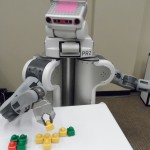 It’s fairly well established, or at least becoming more so, that our best works often build on the input of others. Whether that’s collaborating with people internally or tapping into knowledge from external sources via open innovation, it is growing increasingly common for knowledge work to be done collaboratively.
It’s fairly well established, or at least becoming more so, that our best works often build on the input of others. Whether that’s collaborating with people internally or tapping into knowledge from external sources via open innovation, it is growing increasingly common for knowledge work to be done collaboratively.
New research from the University of Washington highlights how collaborative knowledge sharing can also be incredibly effective for the robotic members of our workforce. The paper focuses on the creation of a protocol whereby the robot can automatically reach out to the crowd for help and advice when it is stuck.
“We’re trying to create a method for a robot to seek help from the whole world when it’s puzzled by something,” said Rajesh Rao, an associate professor of computer science and engineering and director of the Center for Sensorimotor Neural Engineering at the UW. “This is a way to go beyond just one-on-one interaction between a human and a robot by also learning from other humans around the world.”
Traditional methods of teaching a robot how to perform things have involved it learning from the ground up. Such an approach can be time consuming and laborious. The approach suggested by this paper involves giving the robot basic skills and then giving it the skills to learn from the crowd more advanced procedures.
“Because our robots use machine-learning techniques, they require a lot of data to build accurate models of the task. The more data they have, the better model they can build. Our solution is to get that data from crowdsourcing,” said Maya Cakmak, a UW assistant professor of computer science and engineering.
The research team tested their model on a number of experiments. They began simply, requesting that the robot construct simple objects out of lego. The robot initially struggled with the task, and so Mechanical Turk was turned to for help with the model. With over 100 models submitted, the robot tried each before settling on the most effective one.
The team are hoping to apply this approach to teach robots how to perform more complex tasks, such as finding objects in a multi-story building. The hope is that the robots will increasingly be able to engage with humans via the web, learning new skills as they go. You can find out more about this fascinating project via the video below.